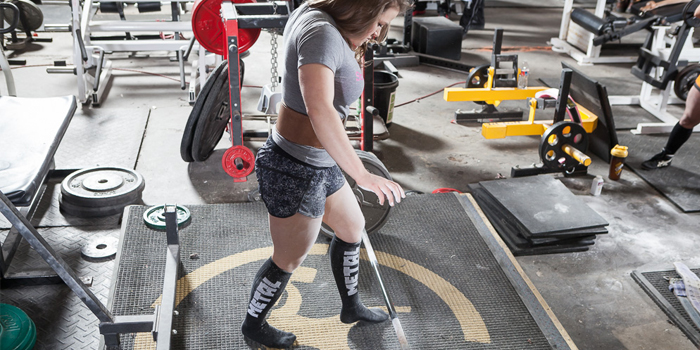
Getting a big deadlift is simple, but not easy. Nothing fancy is needed. Shy away from gimmicks, pound the basics, and train hard. Develop the right mindset, build better technique, and use proper programming. As an experienced strength coach and powerlifter, with a deadlift of 750 pounds, I want to pass along 25 tips for building a brutally strong raw deadlift.
1. Attack the bar. No second-guessing, no hesitation. The bar will expose these things. It’s never a question of if it goes up — it’s only a matter of how fast it will go up. Be confident, aggressive, and attack violently.
MORE: The Sumo Deadlift — You're Doing It the Wrong Way
2. Cultivate the right mentality. Stay focused and driven, and eliminate distractions. When you arrive at the gym, no cell phones or socializing about the weekend. A good training environment and highly motivated training partners can have an extremely positive effect on your training. A great way to keep sessions focused and high-energy is to time rest intervals. General rest interval guidelines:
- For building strength: Sets of fewer than five reps with 85% or more of your 1RM, wait for full recovery (five to seven minutes).
- For building explosive power: Sets of one to three reps with 50-60% of your 1RM, rest for 30 to 60 seconds.
- For hypertrophy (muscle building): Sets of six or more reps with up to 80% of your 1RM, rest 90-180 seconds or a shorter standard of 30 to 90 seconds.
3. Technique first. Work on technique before loading a ton of weight on the bar. Poor form can lead to injuries and plateaus. Longevity is the name of the game — nothing halts progress faster than an injury.
4. Keep it simple. No need to bombard yourself with cues and bog yourself down. The deadlift absolutely requires technique, but it’s a fairly low-skill lift compared to the Olympic lifts, or even the squat and bench press. Use cues that help you lift more efficiently and explosively. If your goal is to lift as much as possible, you don’t want to worry about feeling it in certain muscles. This will only slow you down. The objective is to get the bar from Point A to Point B as efficiently as possible. Cue: SPEED!
5. Always set up the same. Deadlift is concentric-only; you only perform the up portion. Unlike the squat and bench press, your setup is unloaded. Whether there’s 100 pounds or 1000 pounds on the bar, your setup should look the same. Start with the right stance. A good rule of thumb is to set your feet in your vertical jump stance. Stay tight, find your jumping stance (for conventional), and explode through your heels.
6. Think of a push rather than a pull. Think about pushing the floor away, or like you’re pressing the leg press platform away. Too much pulling puts stress on the low back and doesn’t allow for optimal leg drive. When lifters try to pull a heavy weight, you’ll often see that their hips shoot up first, their back rounds, the bar will begin to shift forward, and they miss the lift. My personal favorite cue: find my heels and JUMP! Push through your heels and your body will work as one unit, with your hips and torso rising together.
7. Skim your body with the bar. The line of the bar is crucial. You want the bar to skim your body from start to finish. Strong lats and good technique will help you keep the bar in tight.
8. Don't major in the minors. Specificity is key. If you want to get really good at deadlifting, you have to deadlift. A program promising to add a ton of weight to your deadlift without actually deadlifting won’t work for those with a decent baseline level of strength. Get plenty of practice with the competition lift, then focus on your sticking points.
9. Attack those sticking points. If you’re weak off the floor/below the knee, train movements that strengthen that area. Deficit deadlifts, speed deadlifts, and three-inch block pulls are my favorites. If you’re weak at lockout, try chain deadlifts, band deadlifts, and block pulls. Stiff-legged deadlifts are great for building overall strength and the posterior chain.
10. Don't stress about equipment. Benedikt Magnusson pulled 1015 pounds raw in socks, a belt, and chalk. It works for him and most any conventional puller (I prefer shoes for sumo). If you compete and your federation requires footwear, wrestling shoes or Chucks will work just fine. For a belt, I like a 10-millimeter, single prong.
11. More isn't always better. Over the years, I've experimented with different frequencies and found I respond well to deadlifting once a week. It works well for me. This is true even if I’m training for a deadlift-only meet. It allows for me to recover and hit it hard each week. It's not a high-skill lift (like the snatch or clean and jerk) and doesn't need to be practiced every training session. In general, hard gainers and those with fewer fast-twitch muscle fibers get more benefit from higher frequency training than easy gainers, or those with greater fast-twitch muscle fibers.
12. Be explosive. Speed is king. Speed is also a skill. Train explosively and drive straight through your sticking points! Train with submaximal weights and pulling as fast as possible while maintaining good form. Intention matters; even if it’s heavy, or especially if it’s heavy, commit to being as fast as possible.
13. Should you use bands/chains? If you’re a raw lifter, bands/chains can be a useful tool. However, the majority of training should be done with straight weight. Bands/chains can be effective in developing speed/strength and can be used to build tremendous top end strength, but they should not make up the bulk of your deadlift training.
14. Try both sumo and conventional at some point. It’s the only real way you’ll know which you’re better at. Do this after you’ve already spent ample time training one.
15. Attack your back. It’s often your limiting factor. A stronger back never hurts. Personally, I’ve found myself and many others are able to train upper back two to three times a week and recover. The lower back takes a longer time to recover. For a thicker, stronger back, my personal favorite is the T-Bar prison row, but I love all kinds of rows:
- Barbell Rows
- Seal Rows
- Dumbbell Rows
- Meadow’s Rows
- Batwing Rows
- Low Cable Rows
16. Should you use straps? If you’re a powerlifter, most of your training should be without straps. It is okay to use them sometimes, but most of the time you want to train like you would compete. If you’re a strongman, know what the rules allow and train in the conditions that the competition will be in. If they allow them, you should use them and figure out how to get the most out of them. If you’re not competing, I recommend going without straps most of the time. Use chalk and train your grip.
17. Learn how to get tight! This is often overlooked. Breathe, brace, and develop tension through your body. This allows you to lift more weight and do so more safely. Breathing and bracing is a skill you develop; it takes practice. Keep a neutral spine, fill your torso with air (if you’re wearing a belt, breathe in and fill your entire belted area up with air), and keep your abs tight! I’ve found farmers walks (also great for grip strength), loaded carries, and high-tension planks to be good tools for learning how to develop tension and strength.
18. Spend most of your time building your strength, not testing it. Maxing out regularly leaves me feeling run-down and injury prone. A majority of my deadlifting is submaximal and done as explosively as possible while maintaining good form. Most of my work is done between 55-85%.
19. Use deloads. Deloads help to stay fresh. A reduction in volume and intensity once every four weeks helps my recovery. You’ll feel physically and mentally more prepared after a deload.
20. Save your best for when it counts. If you're grinding out a PR right before the meet, how much can you expect to gain in a week or two? Here are guidelines to peak your deadlift for the platform: Do your heaviest attempt in training around 20-21 days out from the meet (95-96% of target goal). Do your opener (first attempt) 14 days out (90% of target goal). Seven days out, take five to six singles at 60% of target. Example from my last meet:
- Three Weeks Out: 720 Pounds (PR)
- Two Weeks Out: 680 Pounds
- One Week Out: 450 Pounds
- Competition First Attempt: 680 Pounds (90%)
- Competition Second Attempt: 728 Pounds (97% PR)
- Competition Third Attempt: 750 Pounds (100% PR)
21. Visualize success. Before a big lift, before you ever approach the bar, go over the scenario in your head. Visualize the crowd, the noise, the smell, and the walk to the bar. Make it as descriptive as possible. Visualize all of it before it happens, see yourself, and try to feel yourself completing the lift before you ever step to the platform.
22. Get fired up for big lifts. Do this for big lifts, not every lift. You should take all your lifts seriously, even the warm-ups. They’re a great time to practice your speed and technique. But this doesn’t mean you should be amped up for every lift. Save this for your big PR attempts, like a meet. Getting psyched up taxes your CNS. Doing this often can leave you feeling physically and mentally fatigued.
23. Do more first reps. Singles aren't only for maxing out. In powerlifting, you only get one rep on the platform. Because deadlift is concentric only, the movement is changed when doing multiple reps. You benefit from the strength-shortening cycle or stretch reflex on the following reps. Try doing more sets and fewer reps, or cluster sets. Instead of your standard 3x5 setup, try doing 15x1 with shorter rest periods (five times as many first reps). Another way to get more single reps is to reset after each rep. If you’re doing a 5x5, that’s 25 first reps. This is a great way for newer lifters to groove the setup.
24. SQUEEZE! Grip the bar as tight as possible. This will prime your central nervous system and allow you to activate more muscles. Whether your grip's an issue or not, a stronger one never hurts. Build your grip strength with double overhand deadlift ISO holds, farmer's walks, and barbell suitcase deadlifts in the rack (knee height).
25. There is no one perfect technique. People have different body types and thus different optimal techniques. Don’t feel like there is only one way to deadlift. Over time you will find your own optimal technique or style. I think of it like a baseball player's batting stance. Every player has their own style, but by-and-large they’re pretty similar. An experienced coach can help guide you to what works best for you. This is one of the most efficient ways to develop your optimal technique.
If you’d like help finding yours, or you’re looking for a bigger deadlift, shoot me an email at adamnpine@gmail.com with “DEADLIFT” in the subject line. Adam Pine is a strength coach in Boston, an elite level powerlifter with a 750-pound deadlift, and the owner of a rapidly growing online coaching business. You can learn more at www.adampine.com or contact Adam at adamnpine@gmail.com










Thank you for the excellent guidance!
Absolutely, thanks for pointing that out. I wanted to hammer home setting up the same no matter the weight on the bar.
For the squat you can take your heaviest training attempt 10-14 days out. Bench heaviest attempt 7-10 days out.